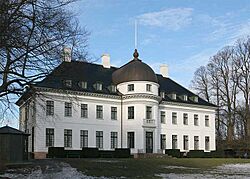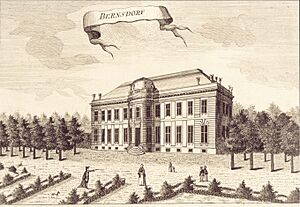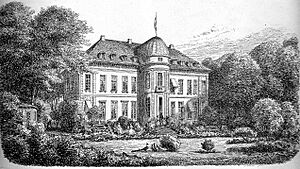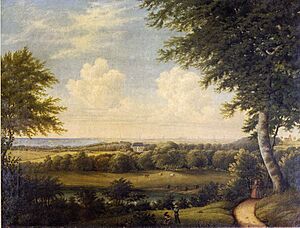Bernstorff Palace facts for kids
Quick facts for kids Bernstorff Palace |
|
|---|---|
|
Bernstorff Slot
|
|

Bernstorff Palace
|
|
| General information | |
| Type | Country house/royal residence |
| Architectural style | Neo-Classicism |
| Town or city | Gentofte |
| Country | Denmark |
| Construction started | 1759 |
| Completed | 1765 |
| Client | Count Johann Hartwig Ernst von Bernstorff |
| Design and construction | |
| Architect | Nicolas-Henri Jardin |
Bernstorff Palace (Danish: Bernstorff Slot) is a beautiful old building in Gentofte, near Copenhagen, Denmark. It was built in the mid-1700s for a very important person, Count Johann Hartwig Ernst von Bernstorff, who was a Foreign Minister.
The palace stayed with the Bernstorff family until 1812. Later, in 1842, King Christian VIII bought it. For many years, it was a favorite summer home for King Christian IX until he passed away in 1906.
More recently, the palace was used by the Danish Emergency Management Agency to train officers. Now, it has a new life as a hotel and conference center, welcoming visitors from all over!
Contents
History of Bernstorff Palace
Building the Palace
The palace was designed by a French architect named Nicolas-Henri Jardin. He came to Denmark to work on Frederick's Church in Copenhagen. Bernstorff Palace is one of the first buildings in Denmark to show the Neoclassical architecture style. This style uses ideas from ancient Greek and Roman buildings.
The palace has two floors and many fancy decorations. It was finished in May 1765, and it cost a lot of money to build! Originally, it had small decorative attics and a wide balcony on the roof. On the side facing the garden, there's a special part with a dome that goes up the whole height of the building.
The rooms inside the palace were not huge, but they were very elegant. They had wooden floors, big mirrors, and decorated ceilings. Four rooms on the south side even had special art above their doors.
Count Bernstorff left Denmark in 1770. His family owned the palace until 1812.
New Owners and a Close Call
After the Bernstorff family, the palace was sold a few times. In 1812, Ole Christian Borch bought it. Then, a year later, he sold it to Frederik Julius Kaas, who was a royal president.
In 1817, a rich plantation owner named Christopher MacEvoy Jr. bought the palace. He had the gardens redesigned in the popular English garden style. However, by the time he died in 1838, Bernstorff Palace was not in good shape.
In 1839, a man named Peter Hilarius Ferdinand Kalko bought the palace. He actually planned to tear down the main building! Luckily, this plan never happened.
A Royal Summer Home
In 1842, just when it was about to be torn down, King Christian VIII bought Bernstorff Palace. He asked Jørgen Hansen Koch to fix it up completely. They added a middle floor and changed how the rooms were laid out on the first floor.
Inside, some of the larger rooms have beautiful fireplaces made of Norwegian marble. Above the entrance, there's a Latin saying that means "Reserved for honest rest between periods of work."
In 1854, Bernstorff Palace became the summer home for Crown Prince Christian, who later became King Christian IX. It became a very popular place for the king, his wife, and their large family to relax. Important guests, like Tsar Alexander III of Russia and Edward VII of the United Kingdom, visited the palace.
In 1888, after a big exhibition, Queen Louise bought a special wooden Swedish pavilion. She had it moved to the palace grounds and turned into guest rooms.
When King Christian IX died in 1906, his son, Prince Valdemar of Denmark, inherited the palace. He continued to use it as a summer home until he died in 1939. Princess Margaret of Denmark, Prince Valdemar's youngest child, was even born at Bernstorff Palace!
What It's Used For Now
After Prince Valdemar's death, the palace was used by the Danish Emergency Management Agency. They trained non-commissioned officers there.
Since May 1, 2009, Bernstorff Palace has been open to the public as a hotel and conference center.
The Palace Gardens
The large gardens around Bernstorff Palace were designed in the Romantic landscape style. This style was new in Denmark in the 1760s. The gardens have big lawns, woods, a rose garden, an orchard, and a tea house. It's thought that Nicolas-Henri Jardin, who designed the palace, also planned the gardens.
The Bernstorff family loved their gardens. They planted many different kinds of fruit trees, like apricots, peaches, grapes, and rare apples and pears. They also grew unusual vegetables like cucumbers, artichokes, and melons from France and the Netherlands. They brought in many rare trees and bushes, such as chestnuts, acacias, holly, and lilacs. Many of these plants were completely new to Denmark at the time.
Most of these special plants had died by the time King Christian IX bought the estate in 1854. He asked the royal garden inspector, Rudolph Rothe, to replace them with Danish oak and beech trees. You can still see these trees in the gardens today.
The beautiful Swedish Villa in the gardens was built in 1888. It's made in the classic Swedish timbered style. Today, the Swedish Villa Foundation runs it, and it's used for art shows, concerts, and as a café.
See also
- Bernstorffstøtten
Images for kids




